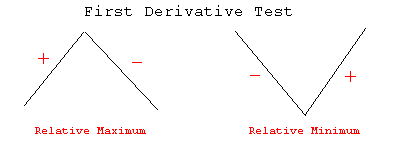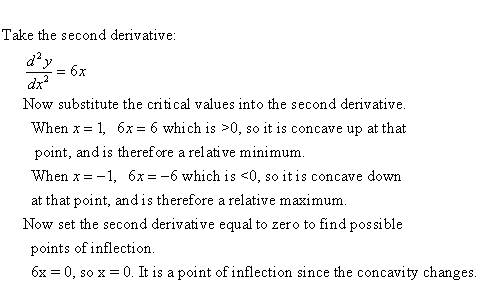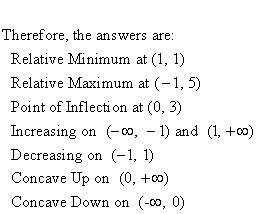|
Quote of the Day:
"I had been to school ... and could say the multiplication table
up to 6 x 7 = 35, and I don't reckon I could ever get any further
than that if I was to live forever. I don't take no stock in
mathematics anyway." -- Huckleberry Finn (by Mark Twain)
Objectives:
The student will test for relative extrema using the first derivative.
The student will test for relative extrema using the second derivative.
The student will sketch curves from given information and without using a calculator.
1. Collect homework.
2. Definitions:
Critical points occur when f'(x) = 0 or when f(x) is not
differentiable. (Slopes are either zero or infinite –
e.g., parabolas or cusps).
Stationary points are those where f'(x) = 0.
The relative extrema of a function (if any) occur at
critical points. But this does not mean that relative
extrema occur at every critical point (they could be
points of inflection, for example).
Relative maximums and minimums may occur when the first
derivative is not zero (like a cusp).
3. To Find relative max/min:
(A) Take the first derivative and set equal to zero.
Solve for x. These are critical points.
(B) 1st derivative test:
Test points on each side of the critical points
found in (A) by substituting in the first
derivative.
If the value of the derivative of the point to
the left of the critical point is positive and
the value of the derivative for the point to
the right is negative, then the critical point
is a relative maximum.
If the value of the derivative of the point to
the left of the critical point is negative and
the value of the derivative for the point to
the right is positive, then the critical point
is a relative minimum.
If the values of the derivative of the points to
the left and the right of the critical point
are the same (i.e., both positive or both
negative), then the critical point is a point
of inflection.

(C) 2nd derivative test:
Take the first derivative and set it equal to
zero to solve for critical points.
Take the second derivative of the function.
Substitute the critical point in the second
derivative.
If this value is negative, the critical point
is a relative maximum.
If this value is positive, the critical point
is a relative minimum.
If this value is zero, the critical point
is a possible point of inflection. Test
points on either side of the critical point
by substituting them into the second
derivative to verify that the concavity
changed.
4. Example:



5. Look at the Top Ten List of Pick Up Lines for Math
Chicks (in math humor) –
#4. My love for you is like the slope of a concave up
function because it is always increasing.
Pick-Up Lines to use on Math Chicks
6. Distribute a copy of the Curve Sketching Techniques and
the Curve Sketching Worksheet.
Curve Sketching Instructions
7. Assignment:
p. 287 (1, 3, 7, 15, 17)
Curve Sketching Worksheet
Click here to go to the next page
|



